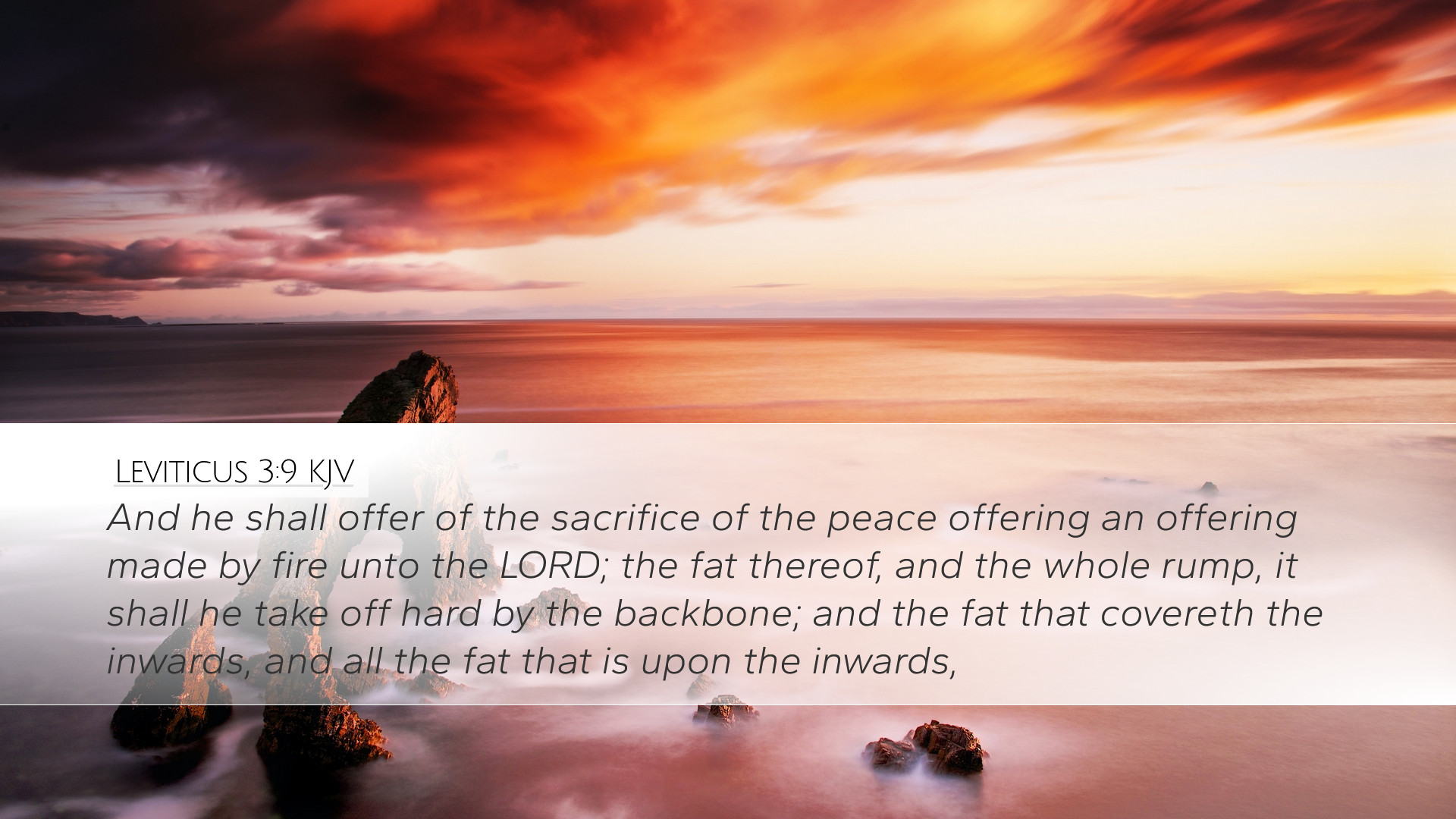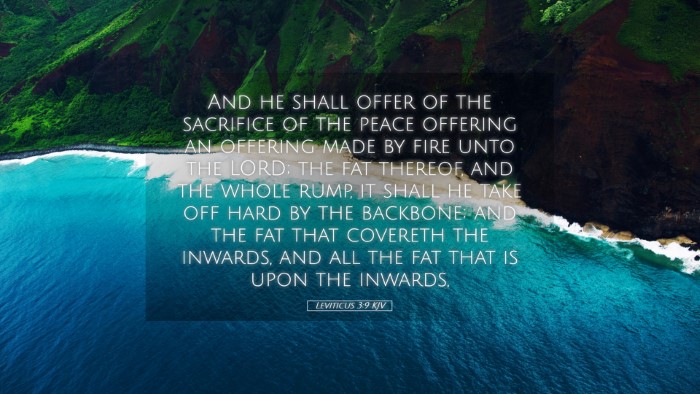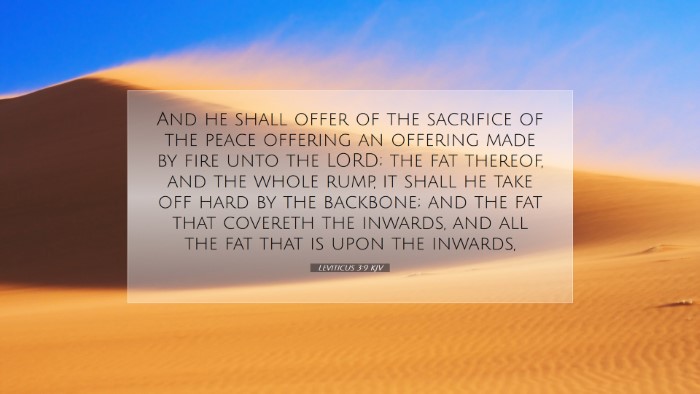Commentary on Leviticus 3:9
Leviticus 3:9 reads: “And he shall offer of the sacrifice of peace offerings an offering made by fire unto the LORD; the fat that covereth the inwards, and all the fat that is upon the inwards.” This verse is part of a detailed set of instructions regarding the peace offerings (or fellowship offerings) in the Mosaic Law. The various commentaries provide profound insights into the significance and implications of this verse for both the ancient Israelite community and contemporary readers.
Overview of Peace Offerings
The peace offering is one of the voluntary sacrifices prescribed in the Book of Leviticus. As noted by Matthew Henry, these offerings symbolize the "harmony between God and man," illustrating a mutual agreement that seeks reconciliation and fellowship. These sacrifices are distinct from the sin and guilt offerings, primarily focused on expressing gratitude and covenant loyalty rather than atonement for sin.
Significance of the Fat
The emphasis on the fat in Leviticus 3:9 carries deep theological significance. In ancient Near Eastern cultures, fat was considered the best part of the animal and was reserved for divine offerings. Albert Barnes states that this allocation underscores the principle of giving God the best of what one has, reflecting an attitude of honor and reverence. The fat represented abundance and was a symbol of the richness of God’s blessings.
- Symbolic Representation: Fat signifies not only physical abundance but also the spiritual excesses that should flow from a life dedicated to God.
- Covenantal Aspect: The offering was part of the covenant relationship where the offerer recognized God's provision in their life.
- Act of Worship: Presenting the fat was viewed as an act of worship wherein the worshipper acknowledges God’s supremacy and sovereignty.
The Inward Parts
The specification of the inwards or internal organs in this offering further illustrates the purity and comprehensiveness of the sacrifice. Adam Clarke elaborates that the inner organs represent the deepest parts of one's being—the soul and spirit. By offering these to God, the worshipper is essentially presenting their entire self in devotion.
- Holistic Offering: This speaks to the completeness required in our approach to God—everything we are must be offered in submission.
- Purity of Intent: It serves as a reminder that God desires our purest intentions and deepest affections in worship.
- Spiritual Connection: The inward is often correlated with our emotions and thoughts, suggesting God seeks fellowship that is sincere and heartfelt.
The Fire and Its Symbolism
The instruction to offer these parts "made by fire unto the LORD" establishes the act of consuming the fat and inward parts on the altar as holy and pleasing to God. Henry points out that fire symbolizes purification and the presence of God, drawing a parallel with the consuming fire of divine holiness. The act of burning signifies that the offering is a sweet aroma to the Lord.
- God's Acceptance: Such offerings were expressions of worship indicating that God delights in the fragrant offerings made by His people.
- Judgment and Purification: Fire also exemplifies the need for purification, illustrating that only what is holy and sanctified may come into communion with God.
- Joyful Fellowship: The peace offerings were often shared, representing joyous fellowship between the worshipper, the priests, and ultimately, God Himself.
The Role of Community in Offerings
Understanding the communal aspect of peace offerings, as noted by Barnes, illuminates the broader societal implications. When individuals brought peace offerings, it often involved communal feasts where all partakers rejoiced together. This communal meal symbolizes unity and shared faith.
- Collective Worship: The peace offering served as a reminder that worship is not merely an individual act but engages the entire community of faith.
- Shared Blessings: The communal nature of sharing the peace offering signifies the shared blessings in God’s kingdom.
- Encouragement of Interpersonal Relationships: Such practices encouraged connections between worshippers, further enhancing the bond within the community of believers.
Application for Today’s Believers
For modern believers, Leviticus 3:9 encourages us to consider what we bring to God in worship and service. It compels reflection on whether we offer Him our best and seek true fellowship in our community of faith. The peace offerings call us to engage actively in our relationship with God and foster community within the Body of Christ.
- Offering the Best: Christians are encouraged to dedicate their best efforts, resources, and time to God, serving as a living sacrifice.
- Seeking Authentic Relationships: Engaging in fellowship with others is essential, remembering that our devotion to God should reflect in our relationships.
- Holistic Worship: True worship extends beyond rituals; it encompasses our entire being, including thoughts, emotions, and actions focused on glorifying God.
Conclusion
In summary, Leviticus 3:9 not only provides insights into ancient sacrificial practices but also offers enduring truths about worship, community, and the believer's relationship with God. The fat and the inward parts symbolize a complete offering of the self, purified and presented in the fire of commitment to God. As scholars, pastors, and students engage with this text, they are reminded of the importance of honoring God with their best, fostering community, and approaching worship with sincerity and holistic devotion.


